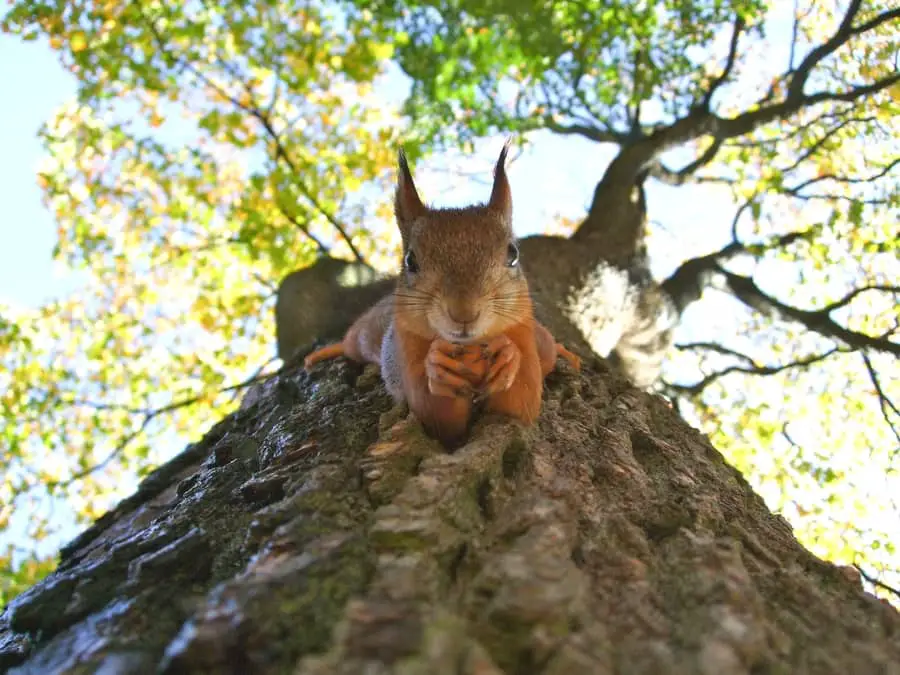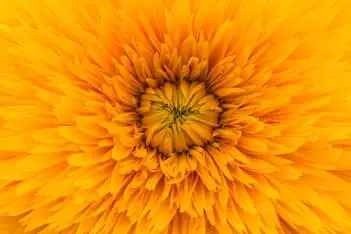Such a shame, you spent all Spring and Summer caring for those mammoth sunflowers, then come bloom time and it’s empty, the seeds have vanished and so has your desire to try growing them again! Don’t despair there are reasons for this as I discovered early on.
So why are there no seeds on my sunflower? The reasons could be varied, ranging from a cultivated variety not designed for pollination, lack of pollination, misinterpretation of what’s happening in the flower, something else got to them first, or possibly but rarely, pests. Let’s take a look at each of these and the possible solutions.
Why Do Sunflowers Produce Seeds
First, let’s just be sure we know why sunflowers produce seeds in the first place. Surprisingly, it’s not so that humans can roast and eat the seeds – although I would highly recommend it. In fact, you can eat the seeds raw, but that’s a whole different subject.
I wrote more extensively about this in my post about Pollination, but in short, the seeds serve the purpose of housing the next generation of sunflowers.
The reason it produces seeds in such large quantities is so that genetically, the probabilities of seeding a new crop of little baby sunflowers become greater.
So it’s purely genetics, but strangely, almost the entire life of the sunflower, every ‘waking moment’ is obsessed with striving for and attaining a fabulous new crop of seeds – it almost sounds familiar!
Sunflowers That Do Not Produce Seeds
Some bright human thought that it would be a good idea to genetically modify certain species of sunflower to NOT produce seeds. Why? Well, in the same way, one might produce seedless grapes. There’s just less mess involved. They do … possibly have a place. They do not produce pollen, so they’re good for hayfever sufferers, and they’re useful for indoor flower displays.
Personally, I just don’t buy these types, they’re show flowers and it just seems a shame to me – even though they do look lovely.
Anyhow, the thing to watch out for is when you purchase the seeds, be sure to check the label as it will clearly tell you if the Sunflower was ‘Bred’ to be seedless.
Yes, they look lovely – as all sunflowers do, but with a huge tinge of sadness, it would seem.
Maybe You Just Can’t See The Seeds!
Strangely, there is a point at which the seeds become more apparent in the sunflower. Let me explain.
Seed husks will begin to form from the outside of the main head, working inwards. Towards the end of this process, it may appear to just look like a blanket across the face, appearing to look like it’s just the plain surface – and not seeds at all.
If in doubt, then once cut (see below on cutting), break open the head and you might see a wall of seeds from the side view
However, these may not always be visible. Sometimes this can be because there’s such a dense covering of pollen, or that seeds are embedded deeper into the green head. Or simply that it hasn’t got to that stage yet.
The way to tell when the seeds are ripe is to look at the back of the plant. If, or when the green base at the back begins to turn yellow – or has turned brown, then you know the seeds should now be visible and just about ready.
Be wary, however, until the seeds have dried out, then being ‘ready’ may still not be apparent to those who have not grown sunflowers before.
If you’re growing sunflowers to harvest the seed heads, whether for human or animal consumption, don’t cut the heads until the green disk at the back of the flower has begun to turn yellow.
At this point, the seeds will mature properly if left on the head and kept in a dry, well-ventilated place. Birds will eat the maturing seed if the heads are not protected.
After the ray flowers have fallen off, cover the head with a cheesecloth or paper bag to keep birds away until you cut it and bring it inside.
Seeds are ready to store or eat when the disk at the back of the flower has turned dark brown. You can easily remove the seeds by rubbing two heads together or just rubbing your palm over the seeds.
Why Sunflowers Are Not Pollinated
Another common reason why you may not see any seeds on the sunflower is simply lack of pollination.
The ‘Build it and they will come’ approach doesn’t always pay off for our yellow petalled friends.
Despite all the flowers’ best efforts to attract our lovely bees, bumble bees, wasps and even moths. Sometimes they just don’t come around as they should.
There are a couple of main reasons behind this.
- Bees are one of their main sources of Pollination. It might be there are limited bees and insects in the area, and not enough to pollinate all the seeds. Ideally, the sunflowers need to be within 300 feet of a beehive to have enough chance of bee pollination.
- It may be the case that there are certain plants, weeds or strong odors in the garden which could be acting as a deterrent to bees and other insects. The way to mitigate against this is mostly by trial and error. It starts by a bit of monitoring of your sunflowers each day. Just take a look and see if you can see bees and other insects dancing around in the center of the flowers. If you can then great. If not, then start to locate the source of what is keeping them away.
As mentioned, to find out more about this subject and how it concerns sunflowers, check out my article on ‘Pollination of sunflowers’
Possible Deterrents to Bee Pollination
I would start by ensuring that there are none of the following flora and fauna around your Sunflowers when planting, or ones that can possibly be moved if you discover this later on.
- Spearmint
- Eucalyptus
- Thyme
Something Beat You to the Seeds!
Squirrels or Marmots are notorious sunflower seed lovers. It is certainly feasible for a squirrel to much his way through an entire Sunflower seed head in one sitting. This may even be at the first light of dawn when no one’s looking. If this is the case, you may well simply find husks scattered around the floor and some seeds left on the plant that are hollow inside.

If your sunflower is growing within dense foliage or grass around its base, then it may not be that you’ve been robbed by a squirrel. Check more closely to be sure.
The other source could be birds, a number of them having a go repeatedly can create a dent in the seed crop. However, they tend not to devour the entire seed crop so fast. So this is one reason you can probably cross off your list of suspects.
Other culprits might include Chipmunks, Racoons, Woodchucks, mice or rats.
Squirrels AND birds together though, now that could be a reason!
Pests of Sunflowers
Thankfully, sunflowers have very, very few arch enemy pests. So this issue is likely to be rare for you. But it’s worth checking out if all the above possibilities still have you scratching your head in dismay. It’s also not always apparent.
The main little mini-beast pest to be aware of is the Cochylis hospes. This little critter will bore its way into each shell of the seed and devour the contents inside, leaving a crop of empty shells behind. It can be controlled, but it can devastate crops if left untreated.
The Final Thing to Try
If none of the above avenues seem to fix your problem and your sunflowers are seedless, or just no sign of seeds on your sunflower then. Then your final and only route is to return it to mother nature and she will do the rest.
By that, I mean, take the sunflower head. Break it up and scatter it over the area where you would like future sunflowers and use a fork or spade to gently turn it over into the soil. IF … there are any seeds left, then maybe mother nature can find them and bring them to life.
Apart from staying away from seedless sunflowers – unless you’re a hay fever sufferer or a flower arranger! I hope that you’ve managed to find an answer to why your sunflower is not producing seeds, or at least may not seem like its producing seeds.
Related Questions
Do Sunflowers Follow The Sun? Sunflowers have an inbuilt mechanism, evolved over many generations, to take full advantage of natural light for the purpose of photosynthesis. You can find out more about that HERE.
If I’ve missed anything, then please add it to the comments below so we can share the knowledge and try to save more sunflower seeds.

